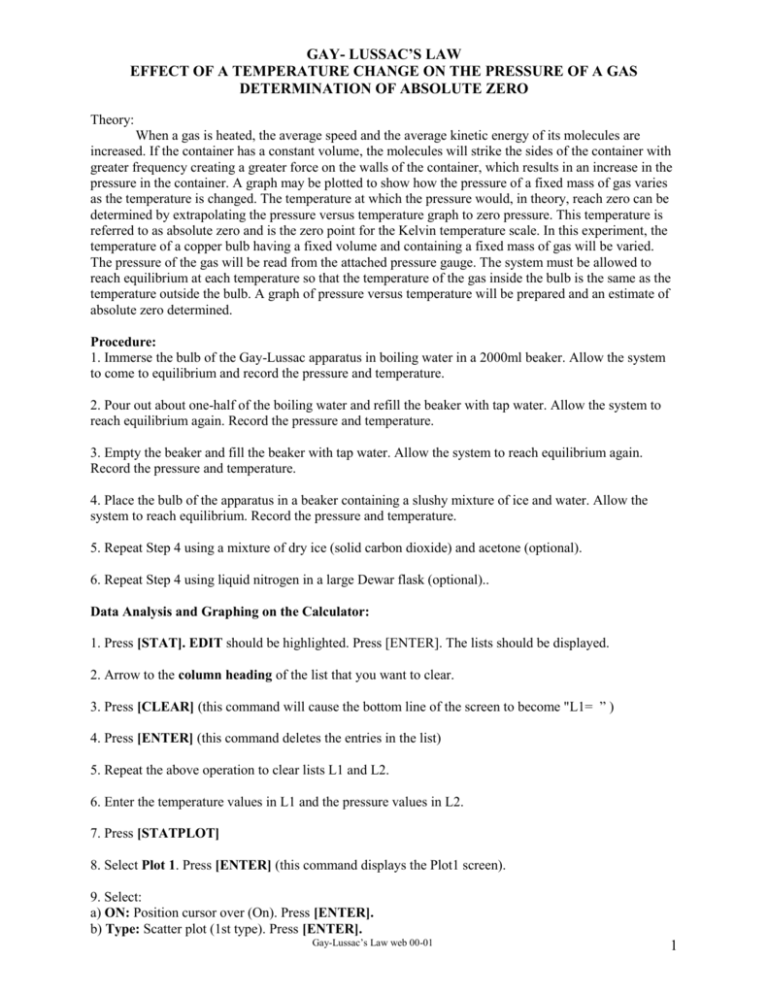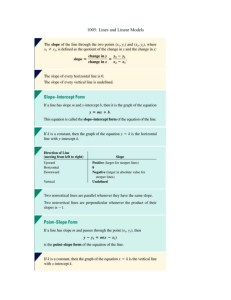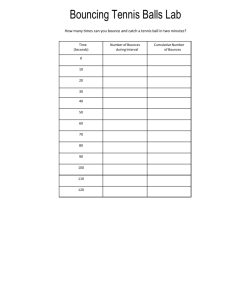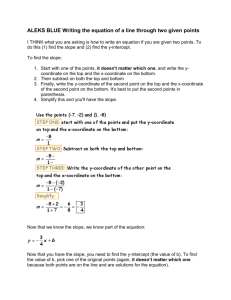Gay Lussac's Law Lab Document
advertisement

GAY- LUSSAC’S LAW EFFECT OF A TEMPERATURE CHANGE ON THE PRESSURE OF A GAS DETERMINATION OF ABSOLUTE ZERO Theory: When a gas is heated, the average speed and the average kinetic energy of its molecules are increased. If the container has a constant volume, the molecules will strike the sides of the container with greater frequency creating a greater force on the walls of the container, which results in an increase in the pressure in the container. A graph may be plotted to show how the pressure of a fixed mass of gas varies as the temperature is changed. The temperature at which the pressure would, in theory, reach zero can be determined by extrapolating the pressure versus temperature graph to zero pressure. This temperature is referred to as absolute zero and is the zero point for the Kelvin temperature scale. In this experiment, the temperature of a copper bulb having a fixed volume and containing a fixed mass of gas will be varied. The pressure of the gas will be read from the attached pressure gauge. The system must be allowed to reach equilibrium at each temperature so that the temperature of the gas inside the bulb is the same as the temperature outside the bulb. A graph of pressure versus temperature will be prepared and an estimate of absolute zero determined. Procedure: 1. Immerse the bulb of the Gay-Lussac apparatus in boiling water in a 2000ml beaker. Allow the system to come to equilibrium and record the pressure and temperature. 2. Pour out about one-half of the boiling water and refill the beaker with tap water. Allow the system to reach equilibrium again. Record the pressure and temperature. 3. Empty the beaker and fill the beaker with tap water. Allow the system to reach equilibrium again. Record the pressure and temperature. 4. Place the bulb of the apparatus in a beaker containing a slushy mixture of ice and water. Allow the system to reach equilibrium. Record the pressure and temperature. 5. Repeat Step 4 using a mixture of dry ice (solid carbon dioxide) and acetone (optional). 6. Repeat Step 4 using liquid nitrogen in a large Dewar flask (optional).. Data Analysis and Graphing on the Calculator: 1. Press [STAT]. EDIT should be highlighted. Press [ENTER]. The lists should be displayed. 2. Arrow to the column heading of the list that you want to clear. 3. Press [CLEAR] (this command will cause the bottom line of the screen to become "L1= ” ) 4. Press [ENTER] (this command deletes the entries in the list) 5. Repeat the above operation to clear lists L1 and L2. 6. Enter the temperature values in L1 and the pressure values in L2. 7. Press [STATPLOT] 8. Select Plot 1. Press [ENTER] (this command displays the Plot1 screen). 9. Select: a) ON: Position cursor over (On). Press [ENTER]. b) Type: Scatter plot (1st type). Press [ENTER]. Gay-Lussac’s Law web 00-01 1 c) Xlist: (horizontal axis) L1. d) Ylist: (vertical axis); L2. e) Mark: Select the small square. Press [ENTER]. 10. After selecting the desired options, press [GRAPH]. 11. Your graph may not display all of your data points (because the graphing window is not set properly); press [ZOOM] Select [ZoomStat] to automatically select a window that displays the full range of your data. Press [ENTER]. What is the apparent relationship between pressure and temperature (direct or inverse). 12. Press [WINDOW]. Enter Xmin = - 350, Xmax = 100, Ymin = 0, and Ymax = 1200 13. Press [GRAPH]. If there is an apparent linear relationship between our two data sets, find the slope and the y-intercept of the line that best fits this linear relationship by the following steps. 14. Press [STAT] 15. Arrow right to CALC. 16. Select LinReg (ax+b) Press [ENTER]. 17. Press [L1] [,] [L2]. Press [ENTER]. 18. The results of the least-squares fit (linear regression) appear on the (LinReg) screen: a = slope of the line b = y-intercept of the line r = correlation coefficient (a measure of how well the this line fits the data . The closer the value is to 1.00, the better the data fits a straight line.) Record these values in the Data Table On the TI-83 If the r value does not appear on the screen, press [CATALOG]. Arrow down to Diagnostic On and press [ENTER] twice. The screen should show Diagnostic On and Done. Run the linear regression analysis again. 19.To display the best-fit line on the graph: a. Press [Y=] b. Press [ENTER] to select Y1. c. Press [CLEAR] to delete any unwanted function. d. Press [VARS] e. Select Statistics. Press [ENTER]. f. Arrow right to EQ since we want an equation. g. Press RegEQ and press [ENTER]. The regression equation appears in the Y1 slot. h. Press [GRAPH] and both the data and the line will be plotted. 20. To solve for the value of absolute zero, use the slope and y-intercept of the regression line to set up the equation, y= ax+b. Absolute zero is the temperature where the volume of the gas equals zero. This is the x-intercept of the line. To calculate this value, set y=0 and solve for x. Gay-Lussac’s Law web 00-01 2 GAY- LUSSAC’S LAW EFFECT OF A TEMPERATURE CHANGE ON THE PRESSURE OF A GAS DETERMINATION OF ABSOLUTE ZERO NAME:_______________________________________ PERIOD:__________ LAB PARTNER:_______________________________ COURSE:_________ Data Table Reading No. Type of Bath Used Temperature (oC) Temperature (K) Pressure (mm Hg) 1 2 3 4 5 6 1. Calculator Results: Linear Regression Statistics: slope (a):_________y-intercept (b):_______ correlation factor (r)_____ Use the slope and y-intercept to calculate a value for absolute zero:___________ SHOW WORK. 2. Graphical Analysis: Use Graphical Analysis to plot a graph of Pressure versus Temperature in oC. This graph should have labeled axes with units. The X-axis should be scaled from 100oC to -300oC (or a value negative enough to clearly show the x-intercept). Be sure to cut off the connecting line option under the Graph menu. Show the linear regression line through your data with the slope, y-intercept, and correlation factor. Use Regression line under the Analyze menu (not the Auto Fit). Attach your graph to the report. 3. Calculate your percent error for absolute zero based on an accepted value of -273 oC. %Error ExperimentalValue 273 273 x100 4. Are pressure and temperature directly or inversely related? Justify your answer based on the results of your graph. 5. Discuss any sources of error that occurred or any improvements that could be made in this lab. Gay-Lussac’s Law web 00-01 3









